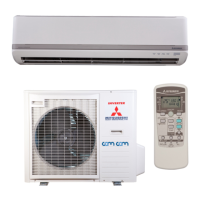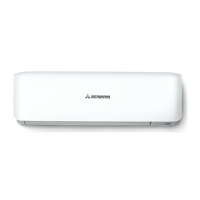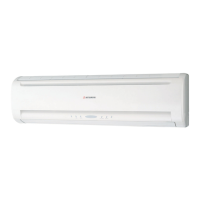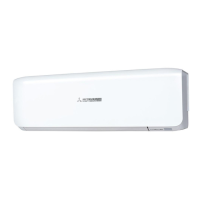Do you have a question about the Mitsubishi SRK63ZR-W and is the answer not in the manual?
| Cooling Capacity | 6.3 kW |
|---|---|
| Heating Capacity | 7.1 kW |
| Seasonal Energy Efficiency Ratio (SEER) | 6.1 |
| Power Supply | 220-240 V, 50 Hz |
| Refrigerant | R32 |
| Indoor Unit Dimensions (W x H x D) | 800 x 295 x 230 mm |
| Outdoor Unit Dimensions (W x H x D) | 800 x 600 x 300 mm |
| Energy Star Rating Cooling | Yes |
| Energy Star Rating Heating | Yes |
| Noise Level (Outdoor Unit) | 50 dB |
| Type | Split |
Essential safety warnings, cautions, and symbol meanings for air-conditioner use.
Critical safety guidelines and warnings specific to the installation process.
Safety measures to follow during the use of the air-conditioner to prevent hazards.
Safety advice and warnings related to moving or repairing the air-conditioner unit.
Advice on setting temperatures, adjusting airflow, and efficient usage for comfort and energy saving.
Identification and description of all parts of the indoor unit.
Identification and description of all parts of the outdoor unit.
Instructions for setting batteries, using the holder, and handling operation failures or warnings.
Detailed explanation of the remote control's buttons, functions, and display indicators for unit operation.
How to operate the unit directly using the ON/OFF button when the remote is unavailable.
How to lock/unlock the remote control to prevent unintended operation.
Adjusting airflow direction and setting the airflow range for optimal room coverage.
Setting the current time and selecting the AUTO operation mode.
Adjusting temperature settings in AUTO mode and controlling fan speed.
Selecting COOL, HEAT, DRY, FAN modes and understanding HEAT mode characteristics.
Automatic control of fan and airflow direction for comprehensive room conditioning.
Setting the unit to stop automatically after a set time with temperature adjustments.
Scheduling the unit to turn off at a specific time.
Scheduling the unit to turn on at a specific time.
Setting ON Timer and OFF Timer simultaneously or combining SLEEP and ON timers.
Utilizing enzymes to remove allergens from the air filter.
Setting up recurring daily and weekly operation schedules.
Using HIGH POWER for rapid conditioning and ECONOMY for energy saving.
Maintaining comfortable temperatures at night and reducing operational noise.
Running a cycle to remove moisture and prevent mold growth inside the unit.
Procedures for cleaning air filters, the unit, and inlet panels to ensure performance.
Steps for removing, inspecting, cleaning, and replacing air-cleaning filters.
A checklist to diagnose and resolve common operational issues before contacting service.
Recommendations for selecting an installation location and ensuring proper ventilation.
Information on airflow issues, noises, smells, and remote signal reception.
Situations requiring dealer contact, auto restart function, and multiple unit operation.
Interpreting error codes indicated by the unit's lights to diagnose malfunctions.












